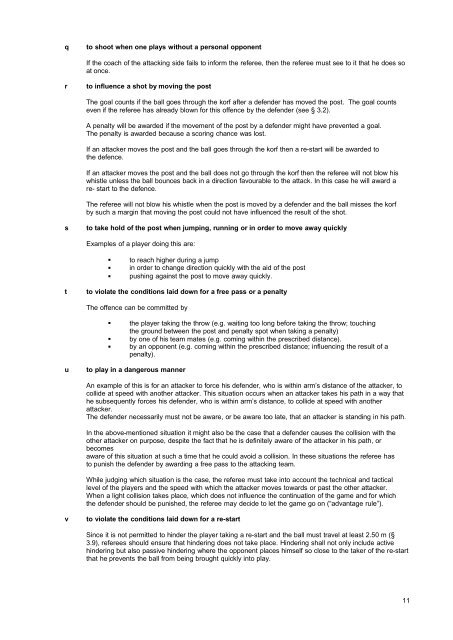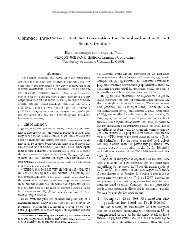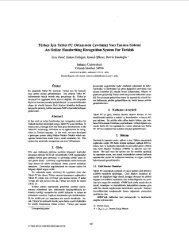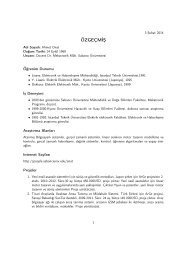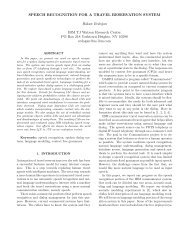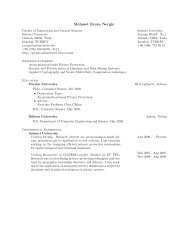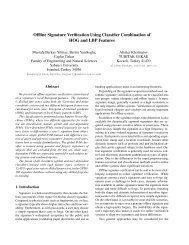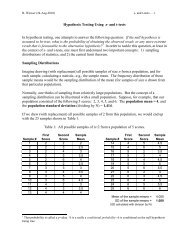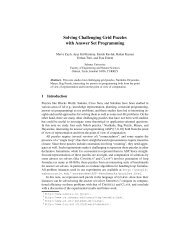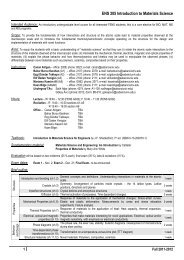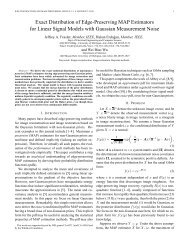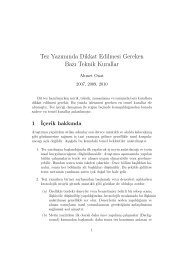mto play outside one’s zoneWhen a player, playing outside his zone, touches <strong>the</strong> ball, <strong>the</strong>n <strong>the</strong> point where <strong>the</strong> ball was touched is<strong>the</strong> point where <strong>the</strong> infringement occurred. The rule regarding <strong>the</strong> touching <strong>of</strong> <strong>the</strong> ball by a player incontact with <strong>the</strong> line applies both to <strong>the</strong> line dividing <strong>the</strong> zones and <strong>the</strong> boundary lines <strong>of</strong> <strong>the</strong> field.For touching <strong>the</strong> ball outside <strong>the</strong> field <strong>of</strong> play see § 3.7.In a case <strong>of</strong> unlawful hindering, <strong>the</strong> re-start must be taken according to § 3.9 b <strong>from</strong> <strong>the</strong> point where<strong>the</strong> hindering occurred.nto shoot <strong>from</strong> a defended positionThe rule against defended shooting is based on <strong>the</strong> desire to prevent slick hand and arm movementsbeing rewarded by a goal, and to encourage players to cooperate toge<strong>the</strong>r to attain free positions <strong>from</strong>which shots may be taken.The rule makes it clear that a shot cannot be considered defended if:1 The defender doesn’t actually try to block <strong>the</strong> shot (<strong>the</strong> simple raising <strong>of</strong> <strong>the</strong> arms is insufficient)2 The body <strong>of</strong> <strong>the</strong> defender is fur<strong>the</strong>r <strong>from</strong> <strong>the</strong> post than that <strong>of</strong> <strong>the</strong> attacker. It is not sufficient when<strong>the</strong> defender's hand or arm is nearer <strong>the</strong> post3 The defender is at a greater distance than arm’s length4 The defender has his back to <strong>the</strong> attacker and is not facing him5 The defender is unaware that <strong>the</strong> attacker has <strong>the</strong> ball in possession (very fast shot, tapping)The rule does not state that <strong>the</strong> defender must actually be able to hinder <strong>the</strong> shot. For instance, when<strong>the</strong> attacker is much taller than <strong>the</strong> defender, <strong>the</strong> attacker will probably always be able to shoot in such away that <strong>the</strong> defender cannot block <strong>the</strong> ball. The shot must be considered defended if <strong>the</strong> defendersatisfies all <strong>of</strong> <strong>the</strong> conditions laid down in § 3.6 n. The same applies when <strong>the</strong> attacker, having jumpedup, shoots or taps <strong>the</strong> ball over <strong>the</strong> hindering arms <strong>of</strong> <strong>the</strong> defender towards <strong>the</strong> korf.If an attacker, hindered by a defender satisfying all <strong>of</strong> <strong>the</strong> conditions mentioned in § 3.6 n, still shoots aftera second defender has started hindering, <strong>the</strong>re is no question <strong>of</strong> an infringement <strong>of</strong> § 3.6 1. Instead <strong>the</strong>attacker is penalised because <strong>of</strong> shooting <strong>from</strong> a defended position.The following cases require special attention:• An attacker receives <strong>the</strong> ball while he has his back to <strong>the</strong> korf and <strong>the</strong> defender is behind himand <strong>the</strong>re<strong>for</strong>e nearer <strong>the</strong> post. If <strong>the</strong> attacker shoots <strong>from</strong> this position, i.e. backwards, <strong>the</strong>nprovided <strong>the</strong> defender satisfies all <strong>of</strong> <strong>the</strong> conditions <strong>of</strong> § 3.6 n <strong>the</strong> shot must be considereddefended.• During an underhand shot against a tall defender, <strong>the</strong>re is <strong>the</strong> possibility that <strong>the</strong> defendertouches <strong>the</strong> ball. This touching can also occur when <strong>the</strong> defender jumps up very high. Touching<strong>of</strong> <strong>the</strong> ball by <strong>the</strong> defender is, in itself, not a reason to consider <strong>the</strong> shot defended. The criterion isthat <strong>the</strong> defender must be within arm's length at <strong>the</strong> instant <strong>the</strong> shot is taken as well as fulfilling<strong>the</strong> o<strong>the</strong>r conditions.• An attacker shoots while running towards <strong>the</strong> post, while <strong>the</strong> defender is behind him. Defendedshooting is <strong>the</strong>n not possible. The defender is allowed to try to block <strong>the</strong> shot by hindering <strong>from</strong>behind, but <strong>of</strong>ten he will <strong>the</strong>n violate § 3.6 j (hinder an opponent excessively). A penalty should<strong>the</strong>n be given if <strong>the</strong> violation causes <strong>the</strong> shot to fail.• An attacker stands in a defended position. If <strong>the</strong> attacker steps, or jumps backwards, (withoutinfringing <strong>the</strong> running rule - § 3.6 d) and shoots, and <strong>the</strong> defender tries to follow <strong>the</strong> movement <strong>of</strong><strong>the</strong> attacker and actually tries to block <strong>the</strong> shot, <strong>the</strong>n <strong>the</strong> shot must be considered defended,even if <strong>the</strong> attacker is <strong>for</strong> a short period out <strong>of</strong> arm’s length.oto shoot after cutting past ano<strong>the</strong>r attackerIf <strong>the</strong> defender is not at arm’s length <strong>from</strong> <strong>the</strong> attacker when <strong>the</strong> attacker runs close by a team mate,<strong>the</strong>n <strong>the</strong>re can be no question <strong>of</strong> 'cutting' and <strong>the</strong> shot must be allowed.When a defender cannot follow an attacker because ano<strong>the</strong>r attacker deliberately moves into <strong>the</strong> path <strong>of</strong><strong>the</strong> defender <strong>the</strong>n <strong>the</strong> 'cutting' is a <strong>for</strong>m <strong>of</strong> holding-<strong>of</strong>f (§ 3.6 i) and a re-start is awarded against <strong>the</strong> o<strong>the</strong>rattacker, whe<strong>the</strong>r or not <strong>the</strong> first attacker shoots after <strong>the</strong> 'cutting'.pto score <strong>from</strong> <strong>the</strong> defence zone <strong>of</strong> <strong>the</strong> attacking team or directly <strong>from</strong> a free pass or a re-start10
qto shoot when one plays without a personal opponentIf <strong>the</strong> coach <strong>of</strong> <strong>the</strong> attacking side fails to in<strong>for</strong>m <strong>the</strong> referee, <strong>the</strong>n <strong>the</strong> referee must see to it that he does soat once.rto influence a shot by moving <strong>the</strong> postThe goal counts if <strong>the</strong> ball goes through <strong>the</strong> korf after a defender has moved <strong>the</strong> post. The goal countseven if <strong>the</strong> referee has already blown <strong>for</strong> this <strong>of</strong>fence by <strong>the</strong> defender (see § 3.2).A penalty will be awarded if <strong>the</strong> movement <strong>of</strong> <strong>the</strong> post by a defender might have prevented a goal.The penalty is awarded because a scoring chance was lost.If an attacker moves <strong>the</strong> post and <strong>the</strong> ball goes through <strong>the</strong> korf <strong>the</strong>n a re-start will be awarded to<strong>the</strong> defence.If an attacker moves <strong>the</strong> post and <strong>the</strong> ball does not go through <strong>the</strong> korf <strong>the</strong>n <strong>the</strong> referee will not blow hiswhistle unless <strong>the</strong> ball bounces back in a direction favourable to <strong>the</strong> attack. In this case he will award are- start to <strong>the</strong> defence.The referee will not blow his whistle when <strong>the</strong> post is moved by a defender and <strong>the</strong> ball misses <strong>the</strong> korfby such a margin that moving <strong>the</strong> post could not have influenced <strong>the</strong> result <strong>of</strong> <strong>the</strong> shot.sto take hold <strong>of</strong> <strong>the</strong> post when jumping, running or in order to move away quicklyExamples <strong>of</strong> a player doing this are:• to reach higher during a jump• in order to change direction quickly with <strong>the</strong> aid <strong>of</strong> <strong>the</strong> post• pushing against <strong>the</strong> post to move away quickly.tto violate <strong>the</strong> conditions laid down <strong>for</strong> a free pass or a penaltyThe <strong>of</strong>fence can be committed by• <strong>the</strong> player taking <strong>the</strong> throw (e.g. waiting too long be<strong>for</strong>e taking <strong>the</strong> throw; touching<strong>the</strong> ground between <strong>the</strong> post and penalty spot when taking a penalty)• by one <strong>of</strong> his team mates (e.g. coming within <strong>the</strong> prescribed distance).• by an opponent (e.g. coming within <strong>the</strong> prescribed distance; influencing <strong>the</strong> result <strong>of</strong> apenalty).uto play in a dangerous mannerAn example <strong>of</strong> this is <strong>for</strong> an attacker to <strong>for</strong>ce his defender, who is within arm’s distance <strong>of</strong> <strong>the</strong> attacker, tocollide at speed with ano<strong>the</strong>r attacker. This situation occurs when an attacker takes his path in a way tha<strong>the</strong> subsequently <strong>for</strong>ces his defender, who is within arm’s distance, to collide at speed with ano<strong>the</strong>rattacker.The defender necessarily must not be aware, or be aware too late, that an attacker is standing in his path.In <strong>the</strong> above-mentioned situation it might also be <strong>the</strong> case that a defender causes <strong>the</strong> collision with <strong>the</strong>o<strong>the</strong>r attacker on purpose, despite <strong>the</strong> fact that he is definitely aware <strong>of</strong> <strong>the</strong> attacker in his path, orbecomesaware <strong>of</strong> this situation at such a time that he could avoid a collision. In <strong>the</strong>se situations <strong>the</strong> referee hasto punish <strong>the</strong> defender by awarding a free pass to <strong>the</strong> attacking team.While judging which situation is <strong>the</strong> case, <strong>the</strong> referee must take into account <strong>the</strong> technical and tacticallevel <strong>of</strong> <strong>the</strong> players and <strong>the</strong> speed with which <strong>the</strong> attacker moves towards or past <strong>the</strong> o<strong>the</strong>r attacker.When a light collision takes place, which does not influence <strong>the</strong> continuation <strong>of</strong> <strong>the</strong> game and <strong>for</strong> which<strong>the</strong> defender should be punished, <strong>the</strong> referee may decide to let <strong>the</strong> game go on (“advantage rule”).vto violate <strong>the</strong> conditions laid down <strong>for</strong> a re-startSince it is not permitted to hinder <strong>the</strong> player taking a re-start and <strong>the</strong> ball must travel at least 2.50 m (§3.9), referees should ensure that hindering does not take place. Hindering shall not only include activehindering but also passive hindering where <strong>the</strong> opponent places himself so close to <strong>the</strong> taker <strong>of</strong> <strong>the</strong> re-startthat he prevents <strong>the</strong> ball <strong>from</strong> being brought quickly into play.11


